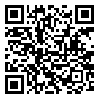1. Abbasi Kasani, H., Shams Mourkani, G., Seraji, F., & Rezaeezadeh, M. (2020). Learners Assessment tools in e-learning. Roshd -e- Fanavari, 16(61), 23-33. https://www.magiran.com/paper/2090464 [
DOI:10.52547/jstpi.20747.16.61.23]
2. Aguilera-Hermida, P. A. (2020). College students' use and acceptance of emergency online learning due to COVID-19. International Journal of Educational Research Open, 1, 100011. [
DOI:10.1016/j.ijedro.2020.100011] [
PMID] [
]
3. Al-Faki, I. M., & Khamis, A. H. A. (2014). Difficulties facing teachers in using interactive whiteboards in their classes. American International Journal of Social Science, 3(2), 136-158. https://www.academia.edu/download/33486077/Difficulties_Facing_Teachers_in_Using_Interactive_Whiteboards_in_Their_Classes_March_2014.pdf
4. Arain, S. A., Ali, M., Arbili, L., Ikram, M. F., Kashir, J., Omair, A., & Meo, S. A. (2022). Medical Students and Faculty Perceptions About Online Learning During COVID-19 Pandemic: Alfaisal University Experience [Original Research]. Frontiers in Public Health, 10. [
DOI:10.3389/fpubh.2022.880835] [
PMID] [
]
5. Azlan, C., Wong, J., Tan, L., Huri, M., Ung, N. M., Pallath, V., Tan, C., Yeong, C. H., & Kh, N. (2020). Teaching and learning of postgraduate medical physics using Internet-based e-learning during the COVID-19 pandemic - A case study from Malaysia. Physica Medica, 80, 10-16. [
DOI:10.1016/j.ejmp.2020.10.002] [
PMID] [
]
6. Balakrishnan, V., Teoh, K. K., Pourshafie, T., & Liew, T. K. (2017). Social media and their use in learning: A comparative analysis between Australia and Malaysia from the learners' perspectives. Australasian Journal of Educational Technology, 33(1). [
DOI:10.14742/ajet.2469]
7. Bawa, P. (2020). Learning in the age of SARS-COV-2: A quantitative study of learners' performance in the age of emergency remote teaching. Computers and Education Open, 1, 100016. [
DOI:10.1016/j.caeo.2020.100016] [
]
8. Ghadermazi, S., & Bolandhematan, K. (2021). Representation of school principals' experiences of quality education policy. Journal of School administration, 9(2), 442-483. https://www.magiran.com/paper/2345388
9. Haji, J., Mohammadi Mehr, M., & Muhammad Azar, H. (2021). Describing the Problems of virtual Education via Shad application in Corona Pandemic: This is a phenomenological study. Information and Communication Technology in Educational Sciences, 11(3), 153-174. https://www.magiran.com/paper/2242584
10. Hamzalo, Z., & Rahimi, S. (2019). Investigating the quality of teaching and learning in the happy virtual environment from the perspective of elementary school students in the second semester of the academic year 2018-2019. Journal of new developments in psychology, educational sciences and education, 3(29), 1-14. https://www.magiran.com/paper/2198853
11. Keramati, E., Rahimi, M., & Afra, R. (2022). Investigating the Challenges and Solutions for Doing an Effective Evaluation of Primary School Students by New Teachers in Shad Software. Instruction and Evaluation, 14(56), 69-102. https://www.magiran.com/paper/2460167
12. Liang, M., Luo, J., Zhan, S., Zhan, H., Wen, J., Xue, X., & Li, X. (2023). Evaluation of Online Education in the Era of COVID-19 Pandemic: A Review from Students, Parents, and Teachers' Perspectives. Turkish Online Journal of Educational Technology-TOJET, 22(1), 80-98. https://eric.ed.gov/?id=EJ1375876
13. Lim, J., & Richardson, J. C. (2016). Exploring the effects of students' social networking experience on social presence and perceptions of using SNSs for educational purposes. The Internet and Higher Education, 29, 31-39. [
DOI:10.1016/j.iheduc.2015.12.001]
14. Mirabolghasemi, M., Choshaly, S. H., & Iahad, N. A. (2019). Using the HOT-fit model to predict the determinants of E-learning readiness in higher education: a developing Country's perspective. Education and Information Technologies, 24(6), 3555-3576. [
DOI:10.1007/s10639-019-09945-9]
15. Mirsamadi, F. (2022). Comparison of The Effectiveness of 5E Model and Ganiye Educational Model on Critical Thinking and Creative Thinking of Students [Quantitative-Research]. 2 Journal of Nursing Education, 10(6), 77-87. http://jne.ir/article-1-1321-en.html
16. Mohammadimehr, M. (2021). Designing the Model of Student Support System in the Virtual Learning Environment: A Necessity in the Face of the Corona Crisis. Research in Medical Education, 13(3), 62-71. https://www.magiran.com/paper/2379335 [
DOI:10.52547/rme.13.3.62]
17. Papakonstantinou, A. A. (2023). Teachers’ Perceptions Regarding School Parents’ Online Groups. Education Sciences, 13(1), 60. https://www.mdpi.com/2227-7102/13/1/60 [
DOI:10.3390/educsci13010060]
18. Rezaei, A. (2020). Student learning evaluation during the Corona: Challenges and Strategies. Educational Psychology, 16(55), 179-214. [
DOI:10.22054/jep.2020.52660.3012]
19. Salimi, S., & Fardin, M. A. (2020). The Role of Corona Virus In Virtual Education, with an Emphasis on Opportunities and Challenges. Research in School and Virtual Learning, 8(2), 49-60. [
DOI:10.30473/etl.2020.53489.3249]
20. Veletsianos, G., & Navarrete, C. (2012). Online social networks as formal learning environments: Learner experiences and activities. The International Review of Research in Open and Distributed Learning, 13(1), 144-166. [
DOI:10.19173/irrodl.v13i1.1078]
21. Verkuyl, M., Lapum, J. L., St-Amant, O., Hughes, M., Romaniuk, D., & McCulloch, T. (2020). Exploring Debriefing Combinations After a Virtual Simulation. Clinical Simulation in Nursing, 40, 36-42. [
DOI:10.1016/j.ecns.2019.12.002]
22. Wong, R. (2023). When no one can go to school: does online learning meet students' basic learning needs? Interactive Learning Environments, 31(1), 434-450. [
DOI:10.1080/10494820.2020.1789672]
23. Yang, Y.-T. C. (2008). A catalyst for teaching critical thinking in a large university class in Taiwan: asynchronous online discussions with the facilitation of teaching assistants. Educational Technology Research and Development, 56(3), 241-264. [
DOI:10.1007/s11423-007-9054-5]
24. Zareai, E. (2013). Measuring the Level of Interaction in E-Curriculum of Khajeh Nasir Toosi University of Technology. Educational Measurement, 4(11), 147. https://www.magiran.com/paper/1162161
25. Zeinabadi, H., & Mosavi, T. (2019). Investigate the Status of Education Based on Mooc in Iran's Higher Education; Challenges and Solutions. Journal of Innovation and Value Creation, 12(6), 41-56. http://rimag.ricest.ac.ir/fa/Article/8664
26. Zhang, L., Zhang, X., Duan, Y., Fu, Z., & Wang, Y. (2010). Evaluation of Learning Performance of E-Learning in China: A Methodology Based on Change of Internal Mental Model of Learners. Turkish Online Journal of Educational Technology-TOJET, 9(1), 70-82. https://eric.ed.gov/?id=EJ875766




